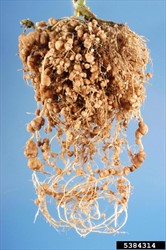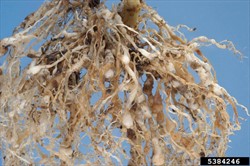Sweet potato - guava root-knot nematode. At first, guava was seen as a common host in China at the time when the nematode was first identified, hence the name. It is also known as the pacara earpod tree root-knot nematode.
Pacific Pests, Pathogens, Weeds & Pesticides - Online edition
Pacific Pests, Pathogens, Weeds & Pesticides
Sweet potato - Guava root knot nematode (540)
Meloidogyne enterolobii. Initially, it was identified as Meloidogyne incognita. Later, it was recognised as a new species, and described from roots of the pacara earpod tree (Enterolobium contortisiliquum) in China. Another species, Meloidoyne mayaguensis, from eggplant in Puerto Rico is closely related.
Asia, Africa, North, South and Central America, the Caribbean, Europe, Oceania. It is recorded from Australia (Northern Territory in 2022).
Many plants are listed by CABI as hosts, including arrowroot, cabbage, celery, coffee, cucumber, eggplant, French bean, guava, pepper, potato, soybean, sweet potato, tomato, and watermelon.
Symptoms and life cycle are like other Meloidogyne species (see Fact Sheet no. 127). Galls form on the roots containing a single or multiple females, resulting in root distortion, dieback, and death (Photos 1&2). Above-ground, plants show poor growth, yellowing and loss of leaves, and wilt and die prematurely. Galls, cracks, and lesions occur on underground storage organs, similar to those on sweet potato (Photo 3).
Adult females feed within the roots and produce eggs either inside or on the surface. A series of juvenile stages develop, the first one inside the egg. The 2nd juvenile stage is the most important as this is the stage that infects the roots. At this time, both males and females are slender and worm-like and, as they feed in the roots, giant cells develop, and galls start to form. The 3rd and 4th stages occur, and then adults. Females remain inside the roots, becoming pear-shaped as they develop eggs and start laying. By contrast, males keep shape, leaving the root to find others to infect, either on the same plant or nearby. The life cycle is about 30 days. Females produce 400-600 eggs.
Spread over short distances is by plant material and soil, e.g., on shoes and machinery. Long distance spread is likely associated with the international movement of plants and potting medium; it may also be associated with the trade in plant commodities, bulbs, tubers, corms, and rhizomes, for instance, the tuberous roots of sweet potato.
An emerging subtropical and tropical pest. Of concern is the ability of Meloidogyne enterolobii to overcome the genetic resistance of crops (e.g., cotton, tomato, sweet potato, capsicum, cowpea) that is relied upon to manage other Meloidogyne species. This nematodes is said to be more aggressive than other species: higher infestation rates, larger galls, severe stunting of root stocks (tomato and cucumber) and high loss of yields - although detailed comparisons are few.
Sweet potato production in the USA, guava production in Brazil and horticultural production in the Caribbean have all been affected by Meloidogyne enterolobii. Although it originates in subtropical areas, it is also a potential threat to glasshouse crops in cooler regions.
It is possible for guava root-knot nematode to occur with Meloidogyne incognita, Meloidogyne arenaria and Meloidoyne javanica, but it is considered the most damaging species.
Because of the similarity with other Meloidogyne species, samples for identification should be examined by specialists. Esterase profiling and DNA-base methods are available.
BIOSECURITY
The chances of introduction of guava root-knot nematode are high as it has a very wide host range, and it is present in many tropical countries on all continents excluding Antarctica. Countries not yet infested should consider all likely pathways for entry and apply quarantine measures accordingly. Particular attention should be given to the fact that introductions may occur with the trade in horticultural produce and ornamental plants.
Meloidogyne enterolobii is on the A2 list for EPPO. A2 pests are present locally in the EU and it is recommended that they are listed as quarantine pests and regulated. The nematode is also on the Alert List of NAPPO. It is under quarantines in several USA states demanding planting material to be certified free from the guava root-knot nematode or under restricted distribution orders. In North Carolina there is an internal quarantine to restrict its spread.
BIOLOGICAL CONTROL
The bacterium, Pasteuria penetrans, has long been recognised as a potential biocontrol agent for root-knot nematodes. Unfortunately, it cannot be grown outside its host. However, other biocontrol agents are being tried: (i) the fungi, Pochonia chlamydosporia and Purpureocillium (Paecilomyces) lilanicus, have shown some effect in laboratory tests, and (ii) the fungus, Trichoderma harzianum, has been used to manage the nematode on guava.
CULTURAL CONTROL
An integrated approach for the control of Meloidogyne species is usually required: exclusion, cultural control with long crop rotations with non-host species, nematicides, if safe to use, and resistant crop varieties, if available. Once soil is contaminated nematodes can remain viable for many years.
Before planting:
- Potting composts: in nurseries, use soilless potting mix, or sterilised/pasteurised soil mixes.
- Soil solarisation: kill root-knot nematodes (plus other pathogens and weeds) in the top 30 cm of (especially sandy) soil by using transparent polyethylene covers. Moisten soil and cover for 4-6 weeks.
- Fallow land: keep soil bare for 4-6 months, but with frequent cultivation; make sure that weeds are controlled. The method exposes the nematodes to drying by the sun, and to starvation.
- Rotation: growing non-host crops can reduce nematode populations; as mentioned under Resistant Varieties (below) some crops are non-hosts to guava root-knot nematode: e.g., grapefruit, orange, garlic and peanut.
- Grow marigolds: grow a dense planting of, e.g., French marigolds for several months, the incorporate.
During growth:
- Soil amendments: Add manures or composts to the soil, especially to sandy soils, to increase ability of the soil to hold water and nutrients.
- Maintenance: Aim for optimum plant growth by frequent deep watering, and the addition of mulches and organic matter.
After harvest:
- Collect the remains of the crop and burn it.
RESISTANT VARIETIES
Some plants are listed by CABI to be non-hosts: coconut, garlic, grape, grapefruit, mango, mulberry, corn (maize), peanut, and sour orange. In greenhouse tests, none of the varieties of sweet potato - Beauregard, Covington, Evangeline, Hernandez, and Orleans - were found to resist gall formation on fibrous and storage roots, although there were differences between the varieties. Research is on-going in attempts to breed vegetables and fruit crops with tolerance to the nematode.
CHEMICAL CONTROL
A wide range of chemicals has been used for the control of root-knot nematodes, e.g., fumigants (methyl bromide, metham sodium, chloropicrin), liquids and granules (fenamiphos, oxamyl, furadan). Many of these are toxic chemicals that are now restricted or banned. Specialist advice is required to determined what, if any, chemicals are permissible for home or commercial use.
____________________
When using a pesticide, always wear protective clothing and follow the instructions on the product label, such as dosage, timing of application, and pre-harvest interval. Recommendations will vary with the crop and system of cultivation. Expert advice on the most appropriate pesticides to use should always be sought from local agricultural authorities.
AUTHOR Grahame Jackson
Information from Chitambar J (2019) Meloidogyne enterolobii Yang & Eisenbeack 1983. California Department of Food & Agriculture. Pest Rating Profile. (https://blogs.cdfa.ca.gov/Section3162/?tag=meloidogyne-enterolobii); and CABI (2020) Meloidogyne enterolobii (Pacara earpods tree root-knot nematode). Crop Protection Compendium. (https://www.cabidigitallibrary.org/doi/10.1079/cabicompendium.33238); and Chang L et al. (2019) Meloidogyne enterolobii (Yang and Eisenback, 1983). Featured Creatures. Entomology & Nematology. UF/IFAS. University of Florida. (https://entnemdept.ufl.edu/Creatures/NEMATODE/Meloidogyne_enterolobii_Guava_or_pacara_earpod_root_knot_nematode.htm). and Brito J A et al. (2020) Reproduction of
Produced with support from the Australian Centre for International Agricultural Research under project HORT/2016/185: Responding to emerging pest and disease threats to horticulture in the Pacific islands, implemented by the University of Queensland and the Secretariat of the Pacific.






